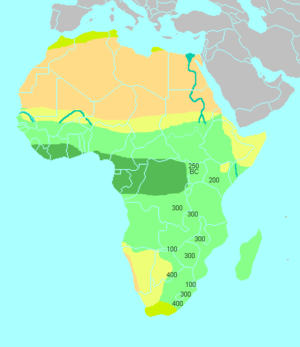
Back توسع البانتو Arabic Espansión bantú AST বান্টু সম্প্রসারণ Bengali/Bangla Expansió bantu Catalan Expansión bantú Spanish Bantuen hedapena Basque Bantuekspansio Finnish Expansion bantoue French बैंतू विस्तार Hindi Migrasi Bantu ID

1 = 4,000–3,500 BP: origin
2 = 3,500 BP: initial expansion
"early split": 2.a = Eastern, 2.b = Western[2]
3 = 2,000–1,500 BP: Urewe nucleus of Eastern Bantu
4–7: southward advance
9 = 2,500 BP: Congo nucleus
10 = 2,000–1,000 BP: last phase

The Bantu expansion[3][4][5] was a major series of migrations of the original Proto-Bantu-speaking group,[6][7] which spread from an original nucleus around West-Central Africa. In the process, the Proto-Bantu-speaking settlers displaced, eliminated or absorbed pre-existing hunter-gatherer and pastoralist groups that they encountered.
There is linguistic evidence for this expansion – a great many of the languages which are spoken across sub-Equatorial Africa are remarkably similar to each other, suggesting the common cultural origin of their original speakers. The linguistic core of the Bantu languages, which comprise a branch of the Atlantic-Congo language family, was located in the southern regions of Cameroon.[8] Genetic evidence also indicates that there was a large human migration from central Africa, with varying levels of admixture with local population.[4][9]
The expansion is believed to have taken place in at least two waves, between about 4,000 and 2,000 years ago (approximately 2,000 BC to AD 1). Linguistic analysis suggests that the expansion proceeded in two directions: the first went across or along the Northern border of the Congo forest region (towards East Africa),[10] and the second – and possibly others – went south along Africa's Atlantic coast into what is now the Republic of the Congo, Gabon, Cameroon, Democratic Republic of the Congo, and Angola, or inland along the many south-to-north flowing rivers of the Congo River system. The expansion reached South Africa, probably as early as AD 300.[11][12][13][14][15][16][17][18]
- ^ Nurse, Derek; Philippson, Gérard (2003). The Bantu Languages. Routledge. ISBN 978-0-7007-1134-5.[page needed]
- ^ Patin, Etienne; et al. (5 May 2017). "Dispersals and genetic adaptation of Bantu-speaking populations in Africa and North America". Science. 356 (6337): 543–546. Bibcode:2017Sci...356..543P. doi:10.1126/science.aal1988. hdl:10216/109265. PMID 28473590. S2CID 3094410.
- ^ Bostoen, Koen (2018). "The Bantu Expansion". Oxford Research Encyclopedia of African History. doi:10.1093/acrefore/9780190277734.013.191. ISBN 978-0-19-027773-4.
- ^ a b Cite error: The named reference
legacywas invoked but never defined (see the help page). - ^ Grollemund, Rebecca; Branford, Simon; Bostoen, Koen; Meade, Andrew; Venditti, Chris; Pagel, Mark (27 October 2015). "Bantu expansion shows that habitat alters the route and pace of human dispersals". Proceedings of the National Academy of Sciences. 112 (43): 13296–13301. Bibcode:2015PNAS..11213296G. doi:10.1073/pnas.1503793112. PMC 4629331. PMID 26371302.
- ^ Clark, John Desmond; Brandt, Steven A. (1984). From Hunters to Farmers: The Causes and Consequences of Food Production in Africa. University of California Press. p. 33. ISBN 978-0-520-04574-3.
- ^ Adler, Philip J.; Pouwels, Randall L. (2007). World Civilizations: Since 1500. Cengage Learning. p. 169. ISBN 978-0-495-50262-3.
- ^ Berniell-Lee, Gemma; Calafell, Francesc; Bosch, Elena; et al. (2006). "Genetic and Demographic Implications of the Bantu Expansion: Insights from Human Paternal Lineages". Molecular Biology and Evolution. 26 (7): 1581–9. doi:10.1093/molbev/msp069. PMID 19369595.
- ^ Cite error: The named reference
densewas invoked but never defined (see the help page). - ^ Pollard, Elizabeth; Rosenberg, Clifford; Tignor, Robert (2011). Worlds Together, Worlds Apart: A History of the World: From the Beginnings of Humankind to the Present. New York: Norton. p. 289. ISBN 978-0-3939-1847-2.
- ^ Vansina, J. (1995). "New Linguistic Evidence and 'The Bantu Expansion'". Journal of African History. 36 (2): 173–195. doi:10.1017/S0021853700034101. JSTOR 182309. S2CID 162117464.
- ^ Tishkoff, S. A.; Reed, F. A.; Friedlaender, F. R.; et al. (2009). "The Genetic Structure and History of Africans and African Americans". Science. 324 (5930): 1035–44. Bibcode:2009Sci...324.1035T. doi:10.1126/science.1172257. PMC 2947357. PMID 19407144.
- ^ Plaza, S; Salas, A; Calafell, F; Corte-Real, F; Bertranpetit, J; Carracedo, A; Comas, D (2004). "Insights into the western Bantu dispersal: MtDNA lineage analysis in Angola". Human Genetics. 115 (5): 439–47. doi:10.1007/s00439-004-1164-0. PMID 15340834. S2CID 13213447.
- ^ Coelho, M; Sequeira, F; Luiselli, D; Beleza, S; Rocha, J (2009). "On the edge of Bantu expansions: MtDNA, Y chromosome and lactase persistence genetic variation in southwestern Angola". BMC Evolutionary Biology. 9 (1): 80. Bibcode:2009BMCEE...9...80C. doi:10.1186/1471-2148-9-80. PMC 2682489. PMID 19383166. S2CID 7760419.
- ^ De Filippo, C; Barbieri, C; Whitten, M; et al. (2011). "Y-chromosomal variation in sub-Saharan Africa: Insights into the history of Niger–Congo groups". Molecular Biology and Evolution. 28 (3): 1255–69. doi:10.1093/molbev/msq312. PMC 3561512. PMID 21109585.
- ^ Alves, I; Coelho, M; Gignoux, C; et al. (2011). "Genetic homogeneity across Bantu-speaking groups from Mozambique and Angola challenges early split scenarios between East and West Bantu populations". Human Biology. 83 (1): 13–38. doi:10.3378/027.083.0102. PMID 21453002. S2CID 20841059.
- ^ Castrì, L; Tofanelli, S; Garagnani, P; et al. (2009). "MtDNA variability in two Bantu-speaking populations (Shona and Hutu) from Eastern Africa: Implications for peopling and migration patterns in sub-Saharan Africa". American Journal of Physical Anthropology. 140 (2): 302–11. doi:10.1002/ajpa.21070. PMID 19425093.
- ^ "Carte Blanche > M-Net". Beta.mnet.co.za. Archived from the original on 7 January 2012. Retrieved 2011-12-31.[self-published source?]